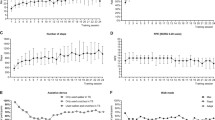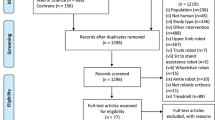Abstract
Spinal cord injury (SCI) is a traumatic event with a global incidence of 23 cases per million, representing 180,000 cases per annum worldwide. Recovery of locomotion is a main priority for spinal cord-injured patients. In addition to overcoming the obvious mobility and social issues related to the inability to stand or walk, regular ambulation may profoundly combat secondary medical problems associated with lack of weight-bearing activity in SCI patients. Lower limb exoskeletons (EXOs) may be devised as an ambulation device, as a rehabilitation tool or may be aimed at allowing both objectives living. Regarding rehabilitation, it is worth noticing that EXOs also provide a perfect environment for precise assessing of rehabilitation protocols and effects. Different is the case of EXO for mobility, where the old wheelchair is still largely winning the challenge: existing exoskeletons have limitations with respect to affordability, size, weight, speed, and efficiency, which may reduce their functional application. In all functional areas (velocity, safety, portability, acceptance as well as autonomy in the ADL) none of today EXOs can compete with the performances of an average wheelchair. However, EXO usage requires learning, and brain changes associated with tool usage introduce the human in the loop concept, a key aspect of clinical relevance for EXO usage. At present, interesting data on the biological mechanisms and rehabilitation relevance of embodiment are providing hints for guiding rehabilitation. In this chapter, these challenges will be presented from a clinical rehabilitation perspective and expectations and critics discussed.
Access this chapter
Tax calculation will be finalised at checkout
Purchases are for personal use only
Similar content being viewed by others
References
Aach M, Cruciger O, Sczesny-Kaiser M, et al. Voluntary driven exoskeleton as a new tool for rehabilitation in chronic spinal cord injury: a pilot study. Spine J. 2014;14:2847–53.
Barbeau H, Fung J. The role of rehabilitation in the recovery of walking in the neurological population. Curr Opin Neurol. 2001;14:735–40.
Barbeau H, Ladouceur M, Norman KE, et al. Walking after spinal cord injury: evaluation, treatment and functional recovery. Arch Phys Med Rehabil. 1999;80:225–35.
Barbeau H, McCrea DA, O’Donovan MJ, et al. Tapping into spinal circuits to restore motor function. Brain Res Rev. 1999;30:27–51.
Bastiaanse CM, Duysens J, Dietz V. Modulation of cutaneous reflexes by load receptor input during human walking. Exp Brain Res. 2000;135:189–98.
Belforte G, Gastaldi L, Sorli M. Pneumatic active gait orthosis. Mechatronics. 2001;11:301–23.
Belda-Lois J-M, Mena-del Horno S, Bermejo-Bosch I, et al. Rehabilitation of gait after stroke: a review towards a top-down approach. J Neuroeng Rehabil. 2011;8:66.
Chen G, Chan CK, Guo Z, et al. A review of lower extremity assistive robotic exoskeletons in rehabilitation therapy. Crit Rev Biomed Eng. 2013;41:343–63.
Creasey GH, Ho CH, RJ, et al. Clinical applications of electrical stimulation after spinal cord injury. J Spinal Cord Med. 2004;27:365–75.
Cruciger O, Tegenthoff M, Schwenkreis P, et al. Locomotion training using voluntary driven exoskeleton (HAL) in acute incomplete SCI. Neurology. 2014;83:474.
Curt A, Hedel HV, Klaus D, Dietz V, Group ESS. Recovery from a spinal cord injury: significance of compensation, neural plasticity, and repair. J Neurotrauma. 2008;25:677–85.
del-Ama A, Koutsou A, Moreno J. Review of hybrid exoskeletons to restore gait following spinal cord injury. J Rehabil Res Dev. 2012;49(4):497–514.
Dietz V. Spinal cord pattern generators for locomotion. Clin Neurophysiol. 2003;114:1379–89.
Dietz V, Colombo G, Jensen L, et al. Locomotor capacity of spinal cord in paraplegic patients. Ann Neurol. 1995;37:574–82.
Dietz V, Colombo G. Effects of body immersion on postural adjustments to voluntary arm movements in humans: role of load receptor input. J Physiol. 1996;497:849–56.
Dietz V, Wirz M, Curt A, et al. Locomotor pattern in paraplegic patients: training effects and recovery of spinal cord function. Spinal Cord. 1998;36:380–90.
Dietz V. Do human bipeds use quadrupedal coordination? Trends Neurosci. 2002;25:462–7.
Dietz V. Neuronal plasticity after a human spinal cord injury: positive and negative effects. Exp Neurol. 2012;235:110–5.
Ditunno JF, Graziani V, Tessler A. Neurological assessment in spinal cord injury. Adv Neurol. 1997;72:325–33.
Ditunno JF Jr, Barbeau H, Dobkin BH, et al. Validity of the walking scale for spinal cord injury and other domains of function in a multicenter clinical trial. Neurorehabil Neural Repair. 2007;21:539–50.
Dobkin B, Apple D, Barbeau H, et al. Weight-supported treadmill vs. over-ground training for walking after acute incomplete SCI. Neurology. 2006;66:484–93.
Dobkin B, Harkema S, Requejo P, et al. Modulation of locomotor-like EMG activity in subjects with complete and incomplete spinal cord injury. J Neurol Rehabil. 1995;9:183–90.
Esquenazi A, Talaty M, Packel A, Saulino M. The ReWalk powered exoskeleton to restore ambulatory function to individuals with thoracic-level motor-complete spinal cord injury. Am J Phys Med Rehabil. 2012;91:911–21.
Farris R, Quintero H, Murray S, et al. A preliminary assessment of legged mobility provided by a lower limb exoskeleton for persons with paraplegia. IEEE Trans Neural Syst Rehabil Eng. 2014;22:482–90.
Ferris DP, Czerniecki JM, Hannaford B. An ankle-foot orthosis powered by artificial pneumatic muscles. J Appl Biomech. 2005;21:189–97.
Fleischer C. Controlling exoskeletons with EMG signals and a biomechanical body model. Dissertation, TU Berlin; 2007.
Fleischer C, Hommel G. Calibration of an EMG-based body model with six muscles to control a leg exoskeleton. In: Proceedings of the 2007 IEEE International Conference on Robotics and Automation (ICRA07). 2007, p. 2514–2519.
Graupe DH, Cerrel-Bazo H Kern, et al. Walking performance, medical outcomes and patient training in FES of innervated muscles for ambulation by thoracic-level complete paraplegics. Neurol Res. 2008;30:123–30.
Harkema S, Dobkin BH, Edgerton VR. Pattern generators in locomotion: implications for recovery of walking after spinal cord injury. Top Spinal Cord Injury Rehabil. 2000;6:82–96.
Harkema SJ, Hurley SL, Patel UK, et al. Human lumbosacral spinal cord interprets loading during stepping. J Neurophysiol. 1997;77:797–811.
Hernigou P. Ambroise pare IV: the early history of artificial limbs (from robotic to prostheses). Int Orthop. 2013;37:1195–7.
Hesse S, Werner C, Paul T, et al. Influence of walking speed on lower limb muscle activity and energy consumption during treadmill walking of hemiparetic patients. Arch Phys Med Rehabil. 2001;82:1547–50.
Hidler J, Sainburg R. Role of robotics in neurorehabilitation. Top Spinal Cord Inj Rehabil. 2011;17:42–9.
Hubli M, Dietz V. The physiological basis of neurorehabilitation–locomotor training after spinal cord injury. J Neuroeng Rehabil. 2013;10:5.
Kawamoto H, Kanbe S, Sankai Y. Power assist method for HAL3 estimating operator’s intention based on motion information. In: Proceedings of the 2003 IEEE International Workshop on Robot and Human Interactive Communication. 2003, p. 67–72.
Kazerooni H. Exoskeletons for human power augmentation. Intelligent Robots and Systems, 2005 (IROS). In: Proceedings of the 2005 IEEE/RSJ International Conference. 2005;3459–64.
Kolakowsky-Hayner SA. Safety and feasibility of using the EksoTM bionic exoskeleton to aid ambulation after spinal cord injury. J Spine 2013;S4:1–8.
Lam T, Wolfe D, Eng J, Domingo A. Lower limb rehabilitation following spinal cord injury. In: Eng JJ, Teasell RW, Miller WC, Wolfe DL, Townson AF, Hsieh JTC, Connolly SJ, Mehta S, Sakakibara BM, editors. Spinal Cord Injury Rehabilitation Evidence. 2010;1–47.
Liu X, Low KH. Development and preliminary study of the NTU lower extremity exoskeleton. Cybernetics and Intelligent Systems, IEEE Conference on 2004 (vol. 2, p. 1099–106).
Liu X, Low KH, Yu HY. Development of a lower extremity exoskeleton for human performance enhancement. Intelligent Robots and Systems, 2004 (IROS). Proceedings of the 2004 IEEE/RSJ International Conference on, 2004 (vol. 4, p. 3889–94).
MacKay-Lyons M. Central pattern generation of locomotion: a review of the evidence. Phys Ther. 2002;82:69–83.
Maegele M, Muller S, Wernig A, et al. Recruitment of spinal motor pools during voluntary movements versus stepping after human spinal cord injury. J Neurotrauma. 2002;19:1217–29.
Marchal-Crespo L, Reinkensmeyer DJ. Review of control strategies for robotic movement training after neurologic injury. J Neuroeng Rehabil. 2009;6:20.
Moreno JC, Barroso F, Farina D, et al. Effects of robotic guidance on the coordination of locomotion. J NeuroEng Rehabil. 2013;10:79.
Moreno JC, Del Ama AJ, de Los Reyes-Guzman A, et al. Neurorobotic and hybrid management of lower limb motor disorders: a review. Med Biol Eng Comput 2011;49:1119–1130.
Neuhaus PD, Noorden JH, Craig TJ, et al. Design and evaluation of mina: a robotic orthosis for paraplegics. IEEE Int Conf Rehabil Robot. 2011; 2011:5975468.
Nightingale EJ, Raymond J, Middleton JW, et al. Benefits of FES gait in a spinal cord injured population. Spinal Cord. 2007;45:646–57.
Pearson KG. Role of sensory feedback in the control of stance duration in walking cats. Brain Res Rev. 2008;57:222–7.
Pons JL. Wearable Robots. Chicester, UK: Wiley; 2008.
Rainetau O, Schwab ME. Plasticity of motor systems after incomplete spinal cord injury. Nat Rev Neurosci. 2001;2:263–73.
Sanz-Merodio D, Cestari M, ArevaloJ C, et al. A lower-limb exoskeleton for gait assistance in quadriplegia. EEE international conference on robotics and biomimetics: ROBIO. 2012;2012:107511–4.
Sawicki GS, Gordon KE, Ferris DP. Powered lower limb orthoses: applications in motor adaptation and rehabilitation. In: Rehabilitation Robotics, 2005 (ICORR). 9th International Conference on 2005, p. 206–11.
Simpson LA, Eng JJ, Hsieh JTC, et al. The Health and life priorities of individuals with spinal cord injury: a systematic review. J Neurotrauma. 2012;29:1548–55.
Stein J, Bishop L, Stein DJ, et al. Gait training with a robotic leg brace after stroke: a randomized controlled pilot study. Am J Phys Med Rehabil. 2014;93:987–94.
Strausser KA, Kazerooni H. The development and testing of a human machine interface for a mobile medical exoskeleton. In: IEEE/RSJ International Conference on Intelligent Robots and Systems (IROS), 2011. Piscataway, NJ: IEEE.
Strausser KA, Swift TA, Zoss AB et al. Prototype medical exoskeleton for paraplegic mobility: first experimental results. In: ASME 2010 dynamic systems and control conference: DSCC, 2010.
Sylos-Labini F, La Scaleia V, d’Avella A, et al. EMG patterns during assisted walking in the exoskeleton. Front Human Neurosci. 2014;8:423.
Thrasher TA, Popovic MR. Functional electrical stimulation of walking: function, exercise and rehabilitation. Ann Readapt Med Phys. 2008;51:452–60.
Van Hedel H, Dietz V. Rehabilitation of locomotion after spinal cord injury. Restor Neurol Neurosci. 2010;28:123–34.
Wernig A, Muller S, Nanassy A, et al. Laufband therapy based on “rules of spinal locomotion” is effective in spinal cord injured persons. Eur J Neurosci. 1995;7:823–9.
Yamamoto K, Ishii M, Noborisaka H et al. Stand alone wearable power assisting suit-sensing and control systems. Robot and Human Interactive Communication, 2004. ROMAN 2004. 13th IEEE International Workshop on 2004, p. 661–6.
Yang JF, Musselman KE. Training to achieve over ground walking after spinal cord injury: a review of who, what, when, and how. J Spinal Cord Med. 2012;35:293–304.
Zeilig G, Weingarden H, Zwecker M, et al. Safety and tolerance of the ReWalk exoskeleton suit for ambulation by people with complete spinal cord injury: a pilot study. J Spin Cord Med. 2012;35:96–101.
Zoss A, Kazerooni H, Chu A. On the mechanical design of the Berkeley Lower Extremity Exoskeleton (BLEEX). Intelligent Robots and Systems, 2005 (IROS). Proceedings of the 2005 IEEE/RSJ International Conference on 2005, p. 3465–72.
Author information
Authors and Affiliations
Corresponding author
Editor information
Editors and Affiliations
Rights and permissions
Copyright information
© 2018 Springer International Publishing AG
About this chapter
Cite this chapter
Molinari, M., Masciullo, M., Tamburella, F., Tagliamonte, N.L., Pisotta, I., Pons, J.L. (2018). Exoskeletons for Over-Ground Gait Training in Spinal Cord Injury. In: Sandrini, G., Homberg, V., Saltuari, L., Smania, N., Pedrocchi, A. (eds) Advanced Technologies for the Rehabilitation of Gait and Balance Disorders. Biosystems & Biorobotics, vol 19. Springer, Cham. https://doi.org/10.1007/978-3-319-72736-3_18
Download citation
DOI: https://doi.org/10.1007/978-3-319-72736-3_18
Published:
Publisher Name: Springer, Cham
Print ISBN: 978-3-319-72735-6
Online ISBN: 978-3-319-72736-3
eBook Packages: EngineeringEngineering (R0)




